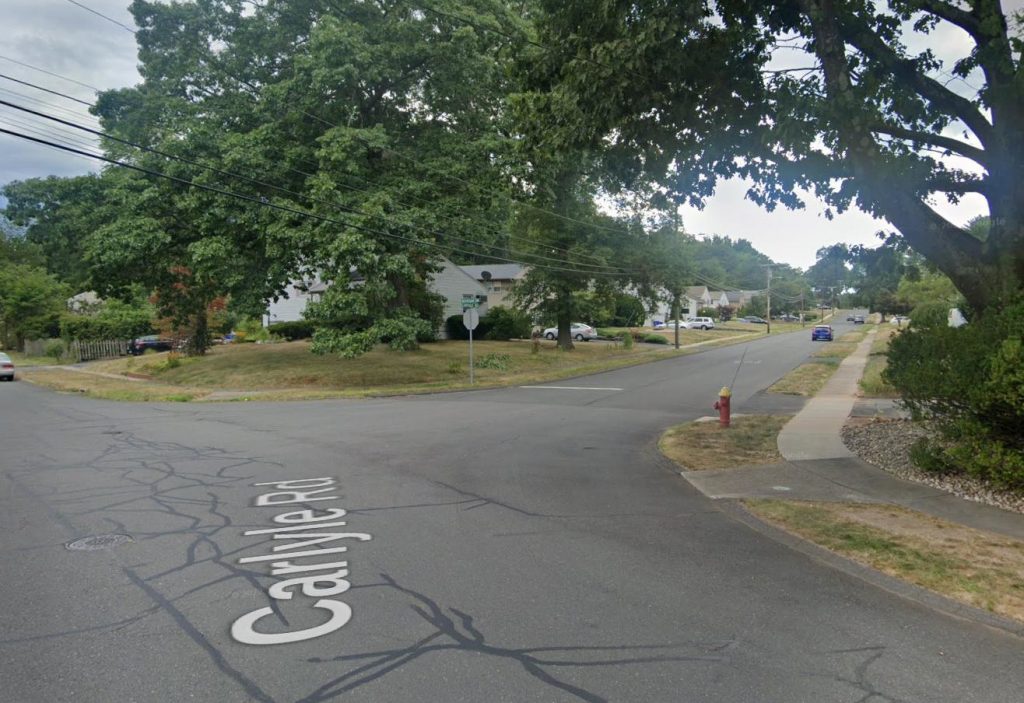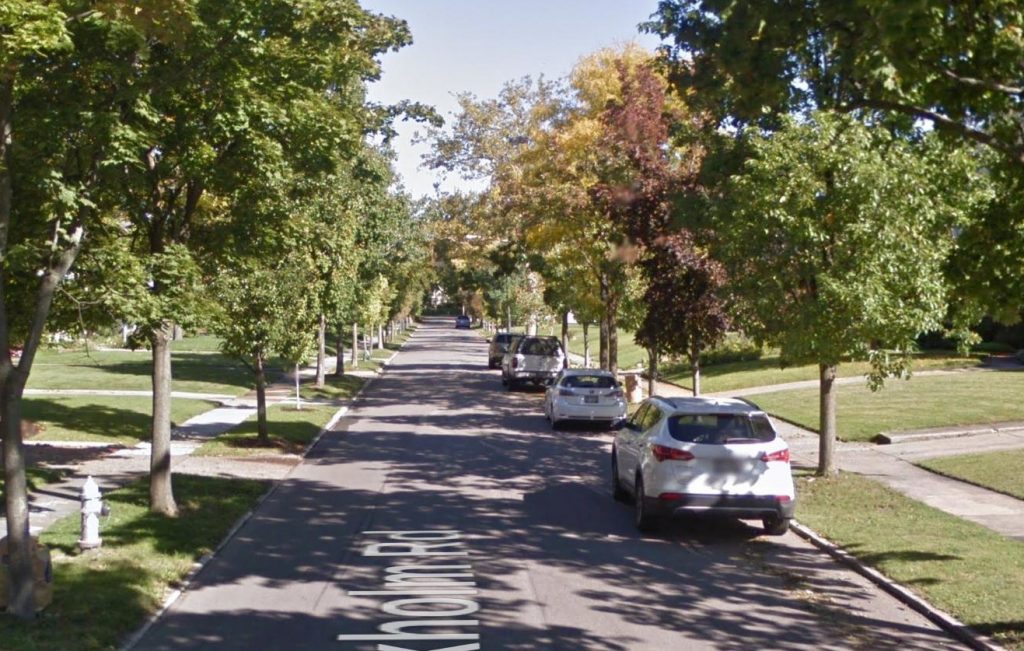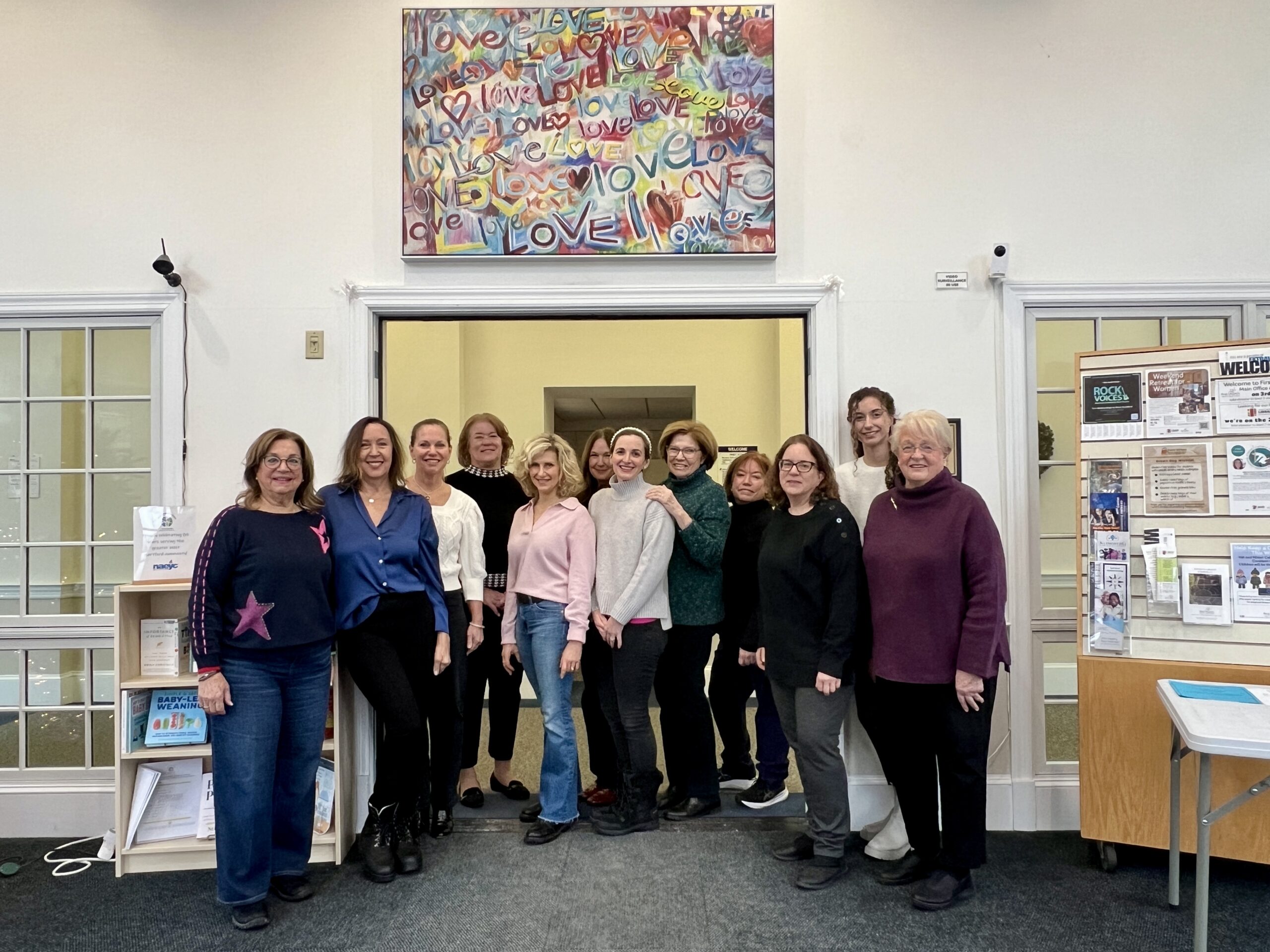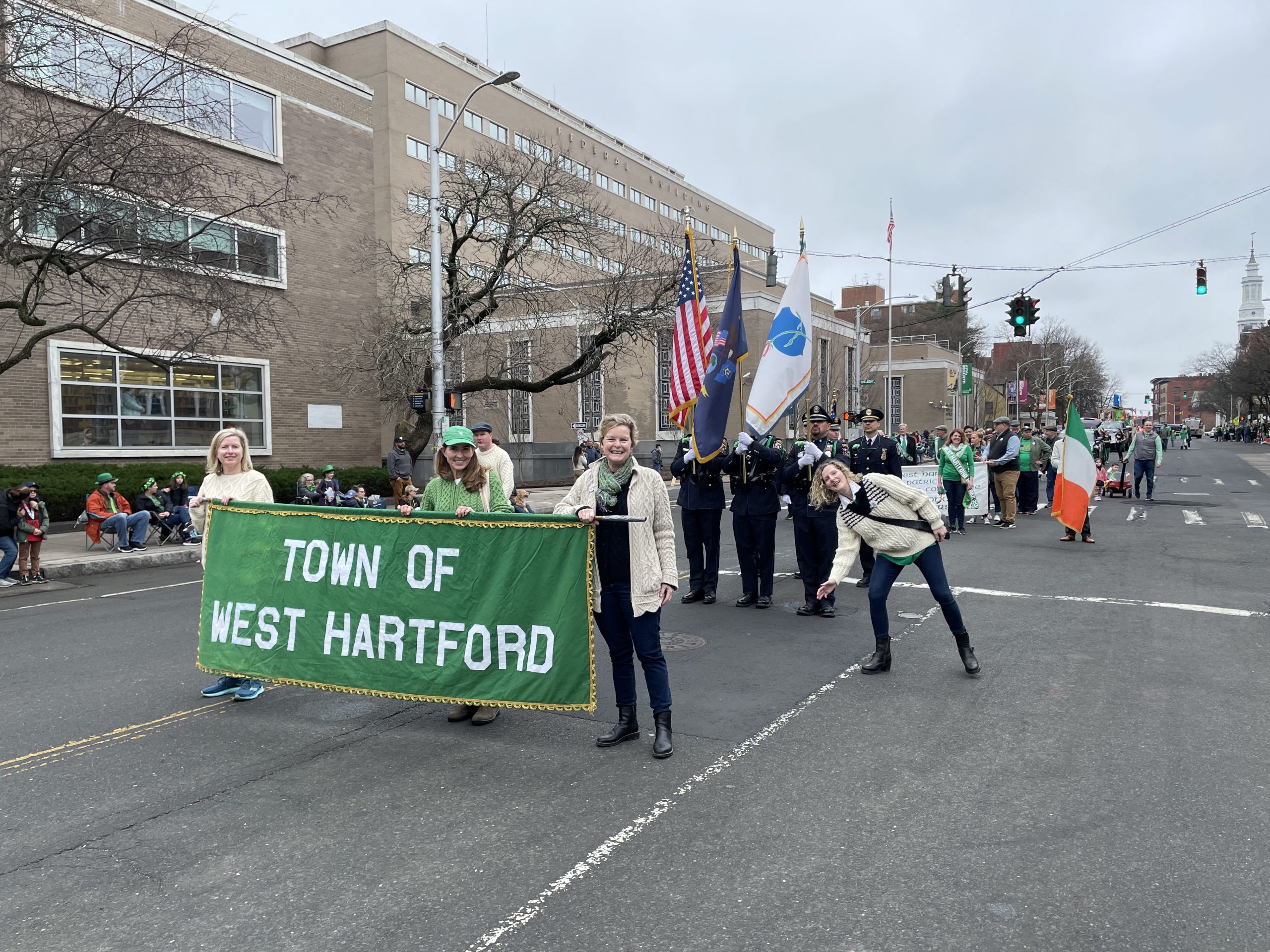Op-Ed: Build Safer Streets Now

Audio By Carbonatix

Mohegan Drive is five car widths across, which is wide enough to drive at life-threatening speeds while checking your phone. Courtesy of Jason Wang
West Hartford resident Jason Wang says road design is a major part of the problem, with streets designed to move vehicle as quickly as possible.
By Jason Wang
I woke up Sunday morning to the news of yet another fatal crash on our roads in West Hartford. This has truly been a nightmare of a week, with three car-vs-pedestrian crashes resulting in two tragic deaths, and on Christmas Day, we had a car crash on Simsbury Road resulting in three more deaths.
I also woke up yesterday morning to a front-page article in the Hartford Courant about our horrendous rising pedestrian fatality rate in Connecticut. In the article, reporter Mike Mavredakis interviewed CT DOT spokesperson Shannon King extensively. I was disappointed to read King’s comments, which solely focused on driver responsibility and behavior modification. According to King, driving behavior has worsened since the pandemic, and drivers “really need to pay attention … put down their cellphones, reduce distractions, never drive impaired. Take your time, reduce the distractions.”
King isn’t absolutely wrong, but the idea that we simply need to tell drivers to drive better is a totally wrongheaded strategy. We are facing a systemic problem. Problematic individual driving behaviors are largely symptoms of a failing system. Rising roadway fatalities is a uniquely American problem among developed nations. We need to stop focusing on blaming individual actions. It would be intellectually dishonest to insist that our uniquely high American road death rate is somehow a product of uniquely bad drivers. Bad drivers exist everywhere. Distracted and impaired drivers exist everywhere. Distracted and impaired pedestrians exist everywhere, too. Yet, somehow people are dying on our roads at much higher rates than the UK, Germany, Canada, Japan, or France.
Distracted driving and roadway deaths are actually symptoms of a transportation system that is rigidly designed to move cars around for as many trips as possible, as quickly as possible, with the least amount of effort possible.
First of all, we have designed a nation where it’s essentially impossible for most Americans to get anywhere without a car, even to buy a gallon of milk. Therefore, nearly everyone must drive. It doesn’t matter if someone is too young and therefore doesn’t assess risk well, or too old and may have slowing reflexes or worsening eyesight. It doesn’t matter if someone is unable to afford decent tires or stay up-to-date on maintenance. It doesn’t matter if someone is distracted or impaired for any number of reasons that we all deal with as humans, including substance use disorders. Essentially, everyone needs to drive to be a functioning member of our society, because of the way we have built our country.
We have also designed a street network that inappropriately tries to move people at high speeds through residential and downtown areas. This was vividly illustrated by our two major car-vs-pedestrian crashes on South Main this year, a road which many townspeople feel is far too wide and fast for a major pedestrian area in the heart of town. The recent tragic crash at the intersection of Mohegan Drive and Carlyle Road is another unfortunate example. Mohegan is approximately 30 feet wide, or about five car widths. The intersection has tremendously wide curb radii, such that a driver would hardly need to slow their car to negotiate the turn. The police have not released details about the crash, but it would be all-too-easy to imagine a driver reaching 40 or 45 miles per hour on a road as seemingly forgiving and wide as Mohegan, and if he or she wanted to turn onto Carlyle, the driver could easily overlook a pedestrian crossing Carlyle. Because of the tremendous curb radii, a pedestrian crossing Carlyle at the intersection would need to walk approximately 65 feet and would be exposed to fast turning traffic the entire time, outside of the beam of driver’s headlights. This is an insane design. It is designed to fail.

Excessively wide curb radii at the intersection of Mohegan and Carlyle allow drivers to take the turn far too quickly, while simultaneously creating an enormous 65 foot crossing for pedestrians. Courtesy of Jason Wang
Paradoxically, we’ve built roads that trick drivers into a sense of safety. Wide roads with forgiving shoulders and monotonous elements reduce the cognitive load of driving. This makes it far more tempting to do other tasks such as fiddle with our phones. There is data showing that some of the most complex and chaotic intersections actually have the lowest injury and crash rates. If you drive up to a simple four-way intersection with a nice, bright, green light, your cognitive load remains low. You can blow through that intersection, barely looking up from your Instagram feed. If you drive past the Boston Common, you need to be on constant high alert for pedestrians, tour buses, and cyclists. Some pedestrians stand so close to the curb you have to take care to not run over their toes. This is an environment that discourages distraction. It focuses your attention. Unless you are a maniac, you would be unlikely to accelerate to 40 MPH while browsing Facebook on your phone and crush a pedestrian on the Boston Common. The whole idea of traffic calming is to systematically introduce complexity to a roadway, and therefore cue drivers to drive more slowly and focus their attention on the road.

A residential road that is three car widths across is far less comfortable to speed on. Not only is the road quite narrow, but the trees enhance the sense of narrowness. This road feels more comfortable at 20 MPH, not 40+ MPH. Courtesy of Jason Wang
There are many other systemic issues that I suspect are contributing to rising roadway fatality rates in our country, in comparison to our developed nation peers. It may be due to the rising prevalence of large SUVs and trucks. Our vehicles are much bigger and therefore deadlier, with more horsepower, more weight, longer stopping distances, worse visibility, less maneuverability, and higher hoods that hit pedestrians and cyclists higher up in the chest and vital organs. It’s certainly possible that we are more stressed out and isolated as a society, which may fuel distraction, disregard for traffic laws, and road rage. Although the police are out there writing tickets as quickly as they can, it’s possible that there is still not enough enforcement to significantly modify behavior compared to pre-pandemic levels, especially compared to many other developed nations which make full use of speed and red light cameras.
On Sunday night our town announced the formation of a task force to address road safety. I applaud this move and hope we can make rapid changes to reduce this horrifying tempo of road deaths. The CT DOT and our leaders need to have a complex, nuanced understanding of our underlying safety issues that have killed over 300 people on our state roadways so far this year. We urgently need and deserve a high-level public discourse about this critical issue. We deserve more than simply blaming individual actions (except in truly egregious cases). Education and shaming people about distracted and impaired driving is not going to make a significant difference.
We need to build better local streets – streets which are not built like highways or racetracks, and which cue drivers to not travel at life-threatening speeds with life-threatening inattention. We need to deploy traffic calming strategies such as physically narrowing streets and planting trees or other landscaping for visual narrowing. We need to add chicanes, medians, protected bike lanes, speed bumps, and corner extensions. And yes, we need to strongly consider traffic cameras, because our police department is already writing thousands more tickets this year compared to last, yet lawless aggressive driving seems to be as prevalent as ever. We deserve a better place to live and a better place for our children to grow up.
We-Ha.com will accept Op-Ed submissions from members of the community. We reserve the right to edit all submitted content.
Like what you see here? Click here to subscribe to We-Ha’s newsletter so you’ll always be in the know about what’s happening in West Hartford! Click the blue button below to become a supporter of We-Ha.com and our efforts to continue producing quality journalism.




Nice thoughts but the town can’t even maintain current roads. Eliminate the pie in the sky dreams and maybe this is affordable
Ralph, our town’s road infrastructure is expensive to maintain because of the amount of cars and trips that the roads encourage. If the town can begin to implement some design elements to encourage more bicycles, pedestrians and mass transit options, not to mention the car safety elements outlined in the letter above, we would begin to see the maintenance budget needed to maintain the roads decrease.
In general, the cost of a smart camera system for a town with 20 square miles of coverage and 220 miles of roads could range from tens of thousands to hundreds of thousands of dollars, depending on the specifics of the system.
There are many companies that design and install smart camera systems for municipalities. Some examples of companies that offer smart camera systems for traffic management include:
Traffic Technology Services: This company provides a range of traffic management solutions, including smart camera systems for traffic monitoring and enforcement.
Redflex Traffic Systems: This company offers a range of smart camera systems for traffic management, including red light and speed cameras, as well as intelligent transportation systems (ITS) for traffic control and management.
Siemens Mobility: This company offers a range of smart camera systems for traffic management, including solutions for traffic monitoring, enforcement, and incident detection.
Kapsch TrafficCom: This company offers a range of smart camera systems for traffic management, including solutions for traffic monitoring, enforcement, and incident detection.
while there’s no one fix to this problem aggressive driving and particularly aggressive pedestrians and cyclist share a big portion of the problem in IMHO. I’ve sat for hours watching people cross the street and so many have the illusion they have the right of way, let me explain pedestrians and cyclist have the right of way but!! they have to make sure the road is clear and if there is a vehicle coming that they acknowledge you have been seen. Cyclist especially think there’s no rules for them, they run lights, cross traffic and weave in and out of traffic.
I see to many pedestrians just cross traffic, come out between parked vehicles assuming hey you have to stop! sorry its car vs human being you will loose every time. We have to be way more careful
this letter addresses lots of options and fixes but we haven’t seen the reports on the crashes yet to determine exactly what happened
traffic cameras should be the last resort.